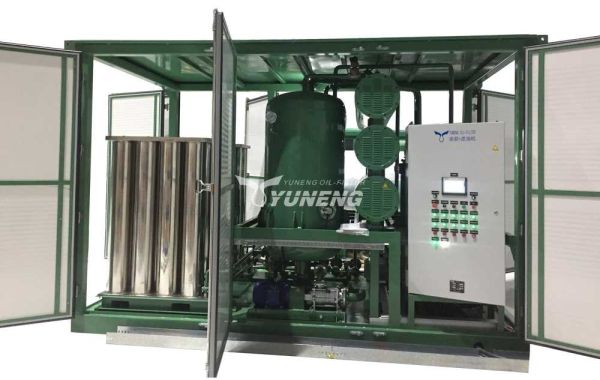The Transformer Oil Reclamation Machine with Reactivated Regeneration Filters is a high - efficiency oil - processing device. It combines multiple technologies to purify and regenerate transformer oil, restoring its performance to a reusable state. Here's a detailed introduction:

I. Vacuum Dehydration and Degassing System
The machine forms a vacuum by extracting air from the vacuum tank with a vacuum pump. Oil enters the filter through the suction valve and passes through the strainer to remove large - particle impurities. Then, it's heated to 50 - 65℃ to reduce the adhesion of impurities, moisture, and gases in the oil. The heated oil enters the vacuum separator, forms a mist and then a film, increasing its contact with air. This allows moisture and gases to quickly vaporize and be discharged by the vacuum system. Water vapor is discharged from the upper part of the vacuum separator. It is first cooled by a condenser. Then, it is cooled by a cooler. The condensed water is collected in a storage tank, and the dried gas is discharged by the vacuum pump.
II. Filtration System
Using a streamline filtration principle, the machine improves oil cleanliness through gradually increasing filtration precision. Before entering the vacuum separator, oil passes through a filter that traps impurities like particles and gums. The filtration system, consisting of a primary filter, fine filter, and regeneration filter, ensures oil cleanliness by intercepting various impurities.
III. Adsorption Regeneration System
The machine has a specially designed regeneration filter. It is filled with adsorbents such as activated alumina, activated clay, and silica gel. These adsorbents can effectively adsorb acidic substances, free carbon, pigments, precipitates, and polar substances from the oil. After vacuum dehydration and degassing, the dried oil is pressurized by a transfer pump, passes through a fine filter to remove residual particles, and then enters the regeneration adsorption unit. The adsorbents restore and enhance the oil's properties through physical and chemical actions.
IV. Heating System
The heating system plays a crucial role in oil purification. The heater consists of sealed finned tubes within a carbon-steel container. It features a multi-circuit heating system. This ensures uniform oil heating. This uniform heating facilitates the vaporization of moisture and gases. It also enhances the adsorption efficiency of the adsorbents. This accelerates the separation of impurities from the oil.
V. Cooling System
The cooling system collects water vapor and other gases evaporated from the vacuum separator. The vapor passes through a radiator. It then enters a cooler where it condenses back into water. The condensed water is collected in a storage tank. The dried gas is discharged by the vacuum pump. The cooling system, comprising a radiator, cooler, and storage tank, ensures stable and safe operation of the equipment.
VI. Automatic Control System
The machine boasts a comprehensive automatic control system with infrared sensors, motors, electromagnetic valves, and protective components. It continuously monitors the equipment's operation, automatically adjusting parameters like heating temperature, liquid level, and vacuum degree to ensure safe, stable, and efficient performance. The system also offers overload, overheating, and leakage protection to prevent faults and accidents.
VII. Online Filtration Security System
The online filtration security system connects oil - filtration, oil - degassing, and oil - drying equipment to transformers. Connected via upper and lower ports with automatic valves, the system stops the unit when abnormalities like oil leakage occur. Operators can set the normal oil level in the transformer tank. If the level is not met, the sensor halts the oil - treatment plant and severs its connection to the transformer. Additionally, air in the hose triggers a vent valve to avert gas - relay malfunctions.
VIII. Equipment Model and Technical Parameters
Taking the ZJA2BY - BO model as an example, the key technical parameters are as follows:
| Item | Parameter |
|---|---|
| Model | ZJA2BY-BO |
| Nominal Flow | 2000L/h |
| Capacity | 33L/min |
| Working Pressure | ≤0.5MPa |
| Limit Vacuum | ≤5-8Pa |
| Working Vacuum | ≤80Pa |
| Operating Oil Temperature | 45~90℃ |
| Power | Customized according to customer needs |
| Heating Power | 20kW |
| Reactivated Regeneration Power | 30kW |
| Total Power | 65kW |
| Lift | ≥15m |
| Working Noise | ≤85dB(A) |
| Oil Inlet/Outlet Diameter | DN25/DN25 |
IX. Oil Treatment Index
After processing with this equipment, the oil meets the following standards:
| Item | Oil Treatment Index |
|---|---|
| Water Content | ≤5ppm |
| Gas Content | ≤0.5%(by volume) |
| Filter Accuracy | 1μm |
| Breakdown Voltage | ≥75kV(spherical electrodes) |
| Acetylene Content | 0 |
| Continuous Working Hours | ≥200 hours |
| Mean Trouble - free Working Time | ≥5000 hours |
In conclusion, the Transformer Oil Reclamation Machine uses multiple technologies. It efficiently purifies and regenerates transformer oil with Reactivated Regeneration Filters. It effectively removes harmful impurities. These include moisture, gases, and acidic substances. This restores the oil's insulating properties, antioxidant capacity, and other physical and chemical indicators. This makes the oil suitable for use in electrical equipment like transformers. It extends equipment life. It reduces operating costs. It minimizes environmental impact. The power industry increasingly focuses on efficiency. It also emphasizes environmental protection and sustainable development. This machine offers significant potential and practical importance.






